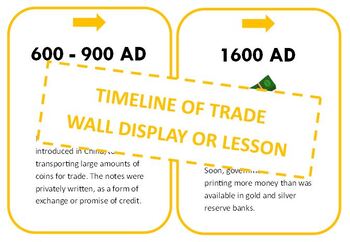Timeline of Trade - Financial Literacy wall display/posters
- Publisher files
Description
Timeline of Trade
This wall display or set of small posters has been developed with the intention to show students the difference between money and currency, including a history spanning several thousand years. As such, it is recommended that when spacing this timeline out, you should use a large space to visually illustrate its magnitude!
Key events in financial history have been included and simplified for classroom use. If you wish to include other events along the timeline, there is an editable document in which you can do so.
Included:
- 1x editable PUB document of 8 key events in financial history with simple clip art and brief descriptions
Why did I create this resource?
Timelines are a fantastic tool that teachers can use as a visual narrative of history; they can stretch for long distances to really give children an idea about the origins of earth, life, early civilisation and modern history.
This timeline goes back to ancient trading routes being established 3,000 BC (approximately 5,000 years ago), with precious metals such as gold and silver being introduced into circulation in the 5th or 6th century BC. The timeline continues through the centuries, outlining when paper notes were introduced to represent larger amounts of coins that took longer to transport, to bank notes that could be exchanged for the gold and silver kept in a bank for safe keeping and investments, to the time when fiat currencies were introduced and the gold standard removed, to money becoming digital and transferable via devices.
When all of this information is laid out before the students, they can see how it is all organised and connected. They can understand that money holds its intrinsic value (e.g. gold or silver) and currency holds no intrinsic value (e.g. fiat currencies backed by the governments that issued it, with no physical monetary value attached to it).
Teacher Tip: Use this resource with physical objects to bring the timeline to life. I try to use objects that represent each key event in financial history. I would bring in some items of trade (or realistic pictures of them), silver bullion coins (99.9% silver), coins with a smaller silver percentage, coins with no silver content, and a variety of bank notes from different countries I’ve visited. If you can’t source any of these items, using realistic pictures or photos can still provide a good visual representation.
For more information on teaching financial literacy and other educational topics, visit my blog at thejoyfulmentor.com
Copyright © 2019 by The Joyful Mentor (rebranded to Ready Teach Learn in 2024, copyrights still apply)
All rights reserved by author.
Permission to copy for single classroom use only.
Electronic distribution limited to single classroom use only.
Not for public display.


